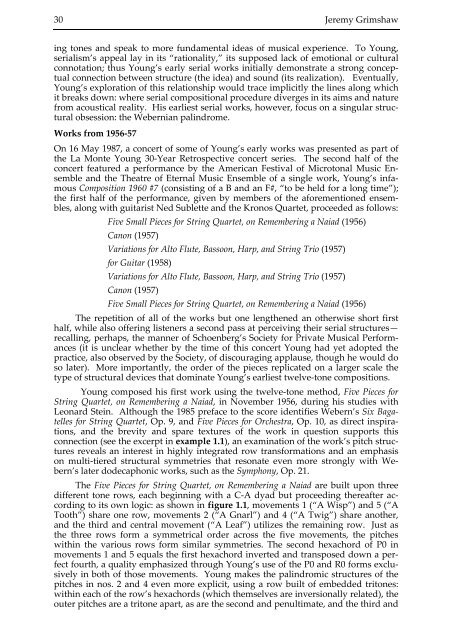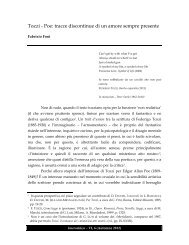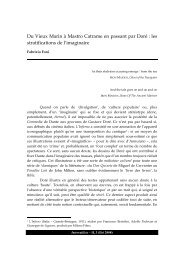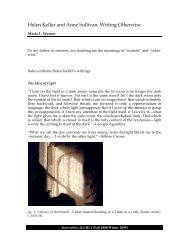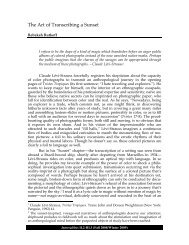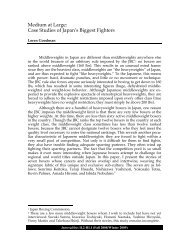The Tabula (not so) Rasa: La Monte Young's Serial Works ... - Cipa
The Tabula (not so) Rasa: La Monte Young's Serial Works ... - Cipa
The Tabula (not so) Rasa: La Monte Young's Serial Works ... - Cipa
Create successful ePaper yourself
Turn your PDF publications into a flip-book with our unique Google optimized e-Paper software.
30 Jeremy Grimshaw<br />
ing tones and speak to more fundamental ideas of musical experience. To Young,<br />
serialism’s appeal lay in its “rationality,” its supposed lack of emotional or cultural<br />
con<strong>not</strong>ation; thus Young’s early serial works initially demonstrate a strong conceptual<br />
connection between structure (the idea) and <strong>so</strong>und (its realization). Eventually,<br />
Young’s exploration of this relationship would trace implicitly the lines along which<br />
it breaks down: where serial compositional procedure diverges in its aims and nature<br />
from acoustical reality. His earliest serial works, however, focus on a singular structural<br />
obsession: the Webernian palindrome.<br />
<strong>Works</strong> from 1956-57<br />
On 16 May 1987, a concert of <strong>so</strong>me of Young’s early works was presented as part of<br />
the <strong>La</strong> <strong>Monte</strong> Young 30-Year Retrospective concert series. <strong>The</strong> second half of the<br />
concert featured a performance by the American Festival of Microtonal Music Ensemble<br />
and the <strong>The</strong>atre of Eternal Music Ensemble of a single work, Young’s infamous<br />
Composition 1960 #7 (consisting of a B and an F#, “to be held for a long time”);<br />
the first half of the performance, given by members of the aforementioned ensembles,<br />
along with guitarist Ned Sublette and the Kronos Quartet, proceeded as follows:<br />
Five Small Pieces for String Quartet, on Remembering a Naiad (1956)<br />
Canon (1957)<br />
Variations for Alto Flute, Bas<strong>so</strong>on, Harp, and String Trio (1957)<br />
for Guitar (1958)<br />
Variations for Alto Flute, Bas<strong>so</strong>on, Harp, and String Trio (1957)<br />
Canon (1957)<br />
Five Small Pieces for String Quartet, on Remembering a Naiad (1956)<br />
<strong>The</strong> repetition of all of the works but one lengthened an otherwise short first<br />
half, while al<strong>so</strong> offering listeners a second pass at perceiving their serial structures—<br />
recalling, perhaps, the manner of Schoenberg’s Society for Private Musical Performances<br />
(it is unclear whether by the time of this concert Young had yet adopted the<br />
practice, al<strong>so</strong> observed by the Society, of discouraging applause, though he would do<br />
<strong>so</strong> later). More importantly, the order of the pieces replicated on a larger scale the<br />
type of structural devices that dominate Young’s earliest twelve-tone compositions.<br />
Young composed his first work using the twelve-tone method, Five Pieces for<br />
String Quartet, on Remembering a Naiad, in November 1956, during his studies with<br />
Leonard Stein. Although the 1985 preface to the score identifies Webern’s Six Bagatelles<br />
for String Quartet, Op. 9, and Five Pieces for Orchestra, Op. 10, as direct inspirations,<br />
and the brevity and spare textures of the work in question supports this<br />
connection (see the excerpt in example 1.1), an examination of the work’s pitch structures<br />
reveals an interest in highly integrated row transformations and an emphasis<br />
on multi-tiered structural symmetries that re<strong>so</strong>nate even more strongly with Webern’s<br />
later dodecaphonic works, such as the Symphony, Op. 21.<br />
<strong>The</strong> Five Pieces for String Quartet, on Remembering a Naiad are built upon three<br />
different tone rows, each beginning with a C-A dyad but proceeding thereafter according<br />
to its own logic: as shown in figure 1.1, movements 1 (“A Wisp”) and 5 (“A<br />
Tooth”) share one row, movements 2 (“A Gnarl”) and 4 (“A Twig”) share a<strong>not</strong>her,<br />
and the third and central movement (“A Leaf”) utilizes the remaining row. Just as<br />
the three rows form a symmetrical order across the five movements, the pitches<br />
within the various rows form similar symmetries. <strong>The</strong> second hexachord of P0 in<br />
movements 1 and 5 equals the first hexachord inverted and transposed down a perfect<br />
fourth, a quality emphasized through Young’s use of the P0 and R0 forms exclusively<br />
in both of those movements. Young makes the palindromic structures of the<br />
pitches in nos. 2 and 4 even more explicit, using a row built of embedded tritones:<br />
within each of the row’s hexachords (which themselves are inversionally related), the<br />
outer pitches are a tritone apart, as are the second and penultimate, and the third and


